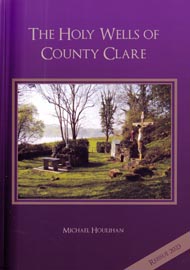The Holy Wells of County Clare
Reissue 2023
Michael Houlihan
Published by Michael Houlihan 2015, reprinted 2023
County Clare contains once of the greatest concentrations of holy wells in Ierland.
While most wells are associated with local saints, some have earlier origins and
different affiliations. In this book Michael Houlihan tours these wells, examining
their long history from earliest times and reviewing their unique traditions. The
defining characteristics of native wells and their distinctive physical features are
explored along the way.
Holy wells have been of service to generations of Irish people. In spite of repeated
waves of invasion and suppression, followed by political and religious strife, over
3,000 wells still exist in Ireland today. They once provided a centre for religious
expression when no other existed, offered shelter in Penal times and served as a
focus for communal solidarity. In Clare, participation was strongest in the decades
before the Famine, when venerated springs made a huge contribution to local
communities. They performed a key role in villages healthcare systems and eased
the pain of bereavement, especially involving infants. The continuing loss of the
Irish language and the slow attrition of long-held folk beliefs, also at this time,
deeply impacted daily life, including holy well usage.
The great holy well paterns of the late 18th century, once the high point
in the rural social calendar, are discussed, including those in Clare on Scattery Island
and Inis Cealtra and at Killone. When the Catholic Church began reasserting itself,
aided in part by Daniel O' Connell's success in the 1828 Ennis by-election, the Patron
Day gatherings and others aspects of folk life were slowly surrendered, as the last
vestiges of the old Gaelic world slipped away. The Famine compounded these changes,
with congregations forfeiting the fields and wells for the new chapels.
The holy wells story continues into the present, including its occasional high
points in the twentieth century. Ten contemporary Clare wells are visited, from
the popular Saint Brigid's at Ballysteen to others since fallen out of favour.
A final section discusses the health of the holy well tradition in the county today.
The book contains nearly 60 colour photographs from across the county, with
some basic maps and tables for those interested in doing their own exploration.
While Clare's holy wells have long been associated with peace and health, they
are also an archaeological and historical treasure trove waiting to be rediscovered.
This book will help those who want to better understand a neglected feature of the
landscape while catching up on a lost part of Clare's social history.
(The text above comes from the back of the book)


